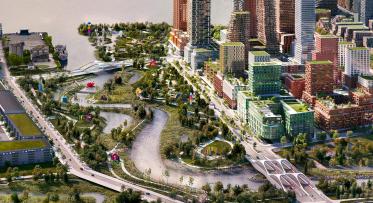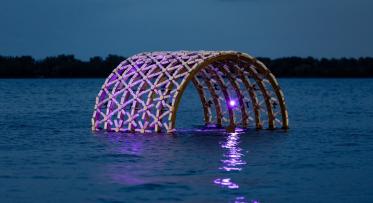Berlin-Based Artists Hadley+Maxwell to Create New ‘Garden of Future Follies’ for Front Street East
By remixing Toronto’s monuments, artists Hadley+Maxwell will create a series of sculptures that will animate the generous, pedestrian-friendly sidewalk at Front Street East at Bayview Avenue in the West Don Lands. (Early rendering, provided by the artist.)
POSTED: NOVEMBER 17, 2014
BY: CIARA MCKEOWN
Recently, Waterfront Toronto awarded a commission to Berlin-based artists Hadley+Maxwell to create a new sculptural installation for the corner of Front Street East and Bayview Avenue in the West Don Lands community. Installation of this new public art work is expected to be completed in late 2016, after the Pan/Parapan American Games. The site is part of a series of “continuous urban rooms” that will define this section of Front Street East. This new commission joins two previously announced public art projects in the same area, which include work by artist Tadashi Kawamata and the Canadian duo Jennifer Marman and Daniel Borins.
Hadley+Maxwell’s work for Front Street will bring the past to life by fragmenting and rearranging parts of monuments, sculptures and architecture from all over the City of Toronto. Based on the idea of follies – fanciful and purely decorative structures that were popular in 18th and 19th century landscape gardens– this project reimagines a ‘garden of follies’ using features from the built environment that are normally inaccessible. The artists will incorporate elements from monuments that are normally high above the street and physically out of reach, bringing them down to street level where they can be celebrated and enjoyed. The work will build a collection of characters that creates a sense of play, inviting us to explore and interact with our city’s history.

For the 19th Biennale of Sydney, Australia, Hadley+Maxwell used a “cinefoil” process to capture the impressions of a variety of fragments of the city’s monuments and architectural features. From over 700 fragments, they produced six new sculptures. Their proposed work for Front Street East will employ a similar process. (From Manners, Habits and Other Received Ideas. Image from the artists’ website.)
The sculptures will be created using a “cinefoil” process, which uses a thick aluminum foil material pressed against an object to take its shape. The aluminum impression is then used to create a mold and cast a bronze version of the original. In the case of Hadley+Maxwell’s work, this often means envisioning how parts of an existing work can create a completely new sculpture. The project site and surrounding landscaping will be designed to flow around the work and build a sense of movement.
With this new public art work, Hadley and Maxwell are tackling the idea of the monument and asking us to question the way we think about public art. This installation will create a unique urban experience along the promenade, engaging passersby with a landscape of sculptures that relate and respond to one another. Imagine the much-loved Guildwood Park in Scarborough, with its forgotten monuments and statues, updated and translated into a walkable, downtown streetscape.
Hadley+Maxwell have been exploring these ideas in their artistic practice since they began working together in 1997. Canadian, but currently Berlin-based, these two artists have exhibited their work in cities all over the world, including Amsterdam, Taipei, Seattle, and Rotterdam. Many Toronto art lovers will also remember their immersive installation for Toronto’s Nuit Blanche in 2012, ‘Smells Like Spirit’. Their body of work includes video and sound-based work and examines the representation of popular culture and ideas of personal/private life versus public appearance. An important aspect of their artistic practice is that process of creating art is as important as the art object created. You can explore many more of their projects in their online portfolio.
A Growing Public Art Collection for the West Don Lands
As part of our revitalization plans, Waterfront Toronto has taken the approach of creating public art master plans and neighborhood plans (also called precinct plans). By planning for public art at the earliest possible stages of our new waterfront communities, we have the opportunity to strategically align public art with new development projects and public realm improvements. We can focus on building a public art collection that prioritizes artistic integrity, contemporary work and design excellence. And, we can ensure that these collections are accessible to everyone by integrating them into dynamic public spaces.
Our West Don Lands Public Art Master Plan is a good example. The plan highlights a cohesive and conceptual approach to creating public art in this new urban neighborhood. Today, we’ve made much progress – completed works include Paul Raff’s Mirage, at Underpass Park, and No Shoes by New York-based artist Mark DiSuvero, in the recently opened Corktown Commons. Three more artworks will be installed by the end of this year – Jill Anholt’s Peeled Pavement, on Mill Street; Daniel Borins and Jennifer Marman’s The Water Guardians, on Front street; and Toronto Lamp Posts by Tadashi Kawamata, also on Front Street.
You can learn more about our approach to Public Art on our website.






